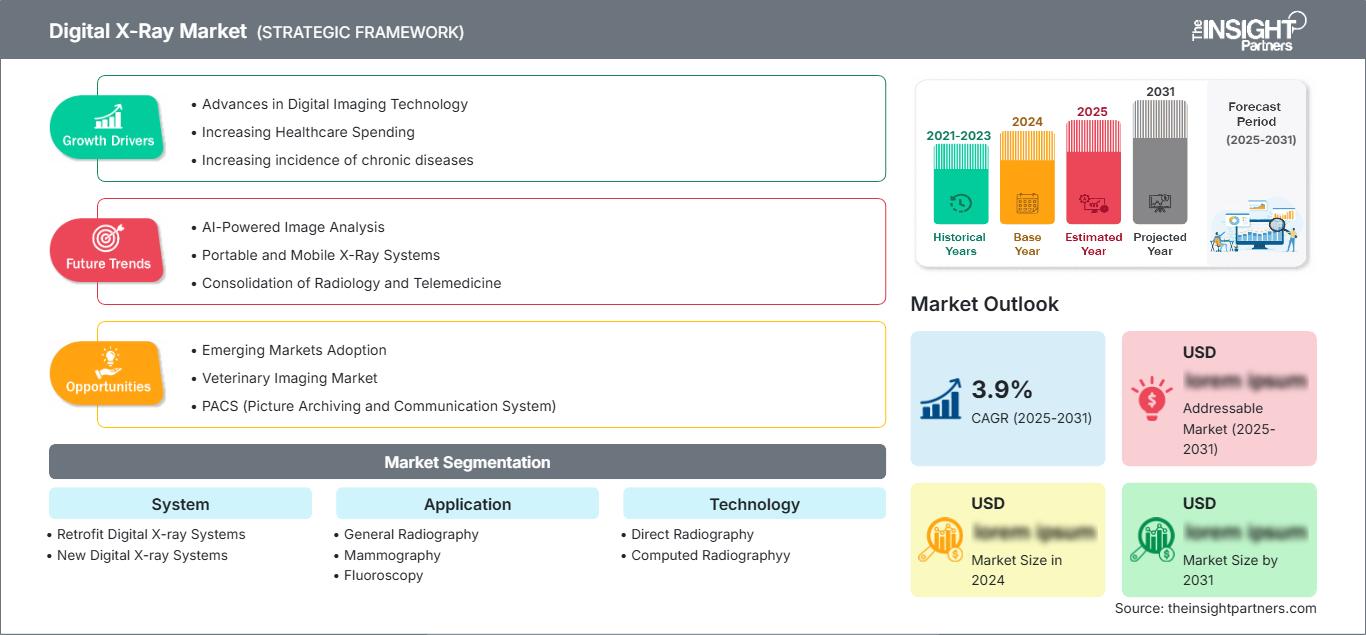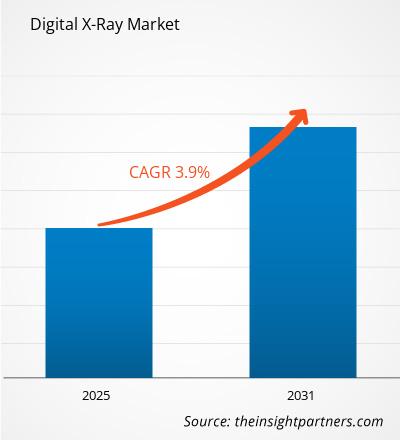Le marché de la radiographie numérique devrait enregistrer un TCAC de 3,9 % entre 2025 et 2031, avec une taille de marché passant de XX millions de dollars américains en 2024 à XX millions de dollars américains d'ici 2031.
Le marché de la radiographie numérique est classé par système dans les sous-segments suivants : systèmes de radiographie numérique modernisés, nouveaux systèmes de radiographie numérique. Il présente également une analyse basée sur l'application, à savoir la radiographie générale, la mammographie, la fluoroscopie, les applications dentaires ; la technologie, à savoir la radiographie directe, la radiographie informatisée ; et la modalité, à savoir les systèmes de radiographie numérique fixes, les systèmes de radiographie numérique portables. L'analyse mondiale est ventilée au niveau régional et par principaux pays. Français L'évaluation du marché est présentée en $ US pour l'analyse segmentaire ci-dessus.
Objectif du rapport
Le rapport sur le marché des rayons X numériques de The Insight Partners vise à décrire le paysage actuel et la croissance future, les principaux facteurs moteurs, les défis et les opportunités. Cela fournira des informations à diverses parties prenantes commerciales, telles que :
- Fournisseurs/fabricants de technologies : pour comprendre l'évolution de la dynamique du marché et connaître les opportunités de croissance potentielles, leur permettant de prendre des décisions stratégiques éclairées.
- Investisseurs : pour réaliser une analyse complète des tendances concernant le taux de croissance du marché, les projections financières du marché et les opportunités qui existent tout au long de la chaîne de valeur.
- Organismes de réglementation : pour réglementer les politiques et surveiller les activités du marché dans le but de minimiser les abus, de préserver la confiance des investisseurs et de maintenir l'intégrité et la stabilité du marché.
Système de segmentation du marché de la radiographie numérique
- Systèmes de radiographie numérique modernisés
- Nouveaux systèmes de radiographie numérique
Application
- Radiographie générale
- Mammographie
- Fluoroscopie
- Applications dentaires
Technologie
- Radiographie directe
- Radiographie informatisée
Modalité
- Systèmes de radiographie numérique fixes
- Systèmes de radiographie numérique portables
Utilisateurs finaux
- Hôpitaux
- Centres de diagnostic
- Autres
Vous bénéficierez d’une personnalisation sur n’importe quel rapport - gratuitement - y compris des parties de ce rapport, ou une analyse au niveau du pays, un pack de données Excel, ainsi que de profiter d’offres exceptionnelles et de réductions pour les start-ups et les universités
Marché de la radiographie numérique: Perspectives stratégiques

- Obtenez les principales tendances clés du marché de ce rapport.Cet échantillon GRATUIT comprendra une analyse de données, allant des tendances du marché aux estimations et prévisions.
Facteurs de croissance du marché de la radiographie numérique
- Progrès de la technologie d'imagerie numérique : Ce facteur comprend le passage de la radiographie analogique à la technologie de radiographie numérique. Les radiographies numériques offrent des images de meilleure qualité, une livraison plus rapide et des capacités de stockage accrues, d'où une meilleure précision du diagnostic.
- Augmentation des dépenses de santé : Grâce à un investissement massif des systèmes de santé dans les dernières technologies d'imagerie, le marché de la radiographie numérique connaît une augmentation des dépenses de santé et des initiatives gouvernementales associées à des outils de diagnostic haut de gamme.
- Incidence croissante des maladies chroniques : à mesure que l'incidence des maladies chroniques comme le cancer, l'arthrite et les maladies cardiaques augmente, le nombre de personnes nécessitant des instruments de diagnostic précis comme les radiographies numériques a augmenté en retour.
Tendances futures du marché des rayons X numériques
- Analyse d'images alimentée par l'IA : avec une plus grande intégration de l'IA dans les systèmes de radiographie numérique, elle aidera à évaluer automatiquement les images radiographiques pour détecter les os fracturés, les tumeurs ou d'autres anomalies qui allègent une partie de la charge de travail des radiologues.
- Systèmes de radiographie portables et mobiles : la tendance est à la portabilité, en particulier pour les urgences et les environnements de soins de santé ruraux, où des unités de radiographie numérique mobiles compactes sont en cours de développement.
- Consolidation de la radiologie et de la télémédecine : les radiographies numériques sont le nouveau fondement de la télémédecine, où les images peuvent être partagées avec des spécialistes situés ailleurs, permettant ainsi d'atteindre plus facilement les patients en périphérie.
Opportunités du marché des radiographies numériques
- Adoption sur les marchés émergents : l'amélioration des infrastructures de santé dans les économies émergentes offre une énorme opportunité pour les systèmes de radiographie numérique, à mesure que les hôpitaux et les centres de diagnostic se modernisent vers des technologies plus avancées.
- Marché de l'imagerie vétérinaire : développer la croissance de l'imagerie vétérinaire : les systèmes de radiographie numérique pénètrent de plus en plus la médecine vétérinaire, offrant une opportunité de croissance pour les entreprises qui se concentrent sur le développement de solutions de radiographie spécifiques pour les animaux.
- PACS (Picture Archiving and Communication System) : Intégration Les radiographies numériques intégrées au système PACS améliorent les processus de stockage, de récupération et d'analyse, offrant aux prestataires de services de santé de nombreuses possibilités d'améliorer leur flux de travail.
Aperçu régional du marché des rayons X numériques
Les tendances régionales et les facteurs influençant le marché de la radiographie numérique tout au long de la période de prévision ont été analysés en détail par les analystes de The Insight Partners. Cette section aborde également les segments et la géographie du marché de la radiographie numérique en Amérique du Nord, en Europe, en Asie-Pacifique, au Moyen-Orient et en Afrique, ainsi qu'en Amérique du Sud et en Amérique centrale.
Portée du rapport sur le marché des rayons X numériques
| Attribut de rapport | Détails |
|---|---|
| Taille du marché en 2024 | US$ XX million |
| Taille du marché par 2031 | US$ XX Million |
| TCAC mondial (2025 - 2031) | 3.9% |
| Données historiques | 2021-2023 |
| Période de prévision | 2025-2031 |
| Segments couverts |
By Système
|
| Régions et pays couverts | Amérique du Nord
|
| Leaders du marché et profils d'entreprises clés |
|
Densité des acteurs du marché de la radiographie numérique : comprendre son impact sur la dynamique des entreprises
Le marché de la radiographie numérique connaît une croissance rapide, portée par une demande croissante des utilisateurs finaux, due à des facteurs tels que l'évolution des préférences des consommateurs, les avancées technologiques et une meilleure connaissance des avantages du produit. Face à cette demande croissante, les entreprises élargissent leur offre, innovent pour répondre aux besoins des consommateurs et capitalisent sur les nouvelles tendances, ce qui alimente la croissance du marché.

- Obtenez le Marché de la radiographie numérique Aperçu des principaux acteurs clés
- Analyse historique (2 ans), année de base, prévision (7 ans) avec TCAC
- Analyse PEST et SWOT
- Taille du marché Valeur / Volume - Mondial, Régional, Pays
- Industrie et paysage concurrentiel
- Ensemble de données Excel
Rapports récents
Rapports connexes
Témoignages
Raison d'acheter
- Prise de décision éclairée
- Compréhension de la dynamique du marché
- Analyse concurrentielle
- Connaissances clients
- Prévisions de marché
- Atténuation des risques
- Planification stratégique
- Justification des investissements
- Identification des marchés émergents
- Amélioration des stratégies marketing
- Amélioration de l'efficacité opérationnelle
- Alignement sur les tendances réglementaires




















 Obtenez un échantillon gratuit pour - Marché de la radiographie numérique
Obtenez un échantillon gratuit pour - Marché de la radiographie numérique